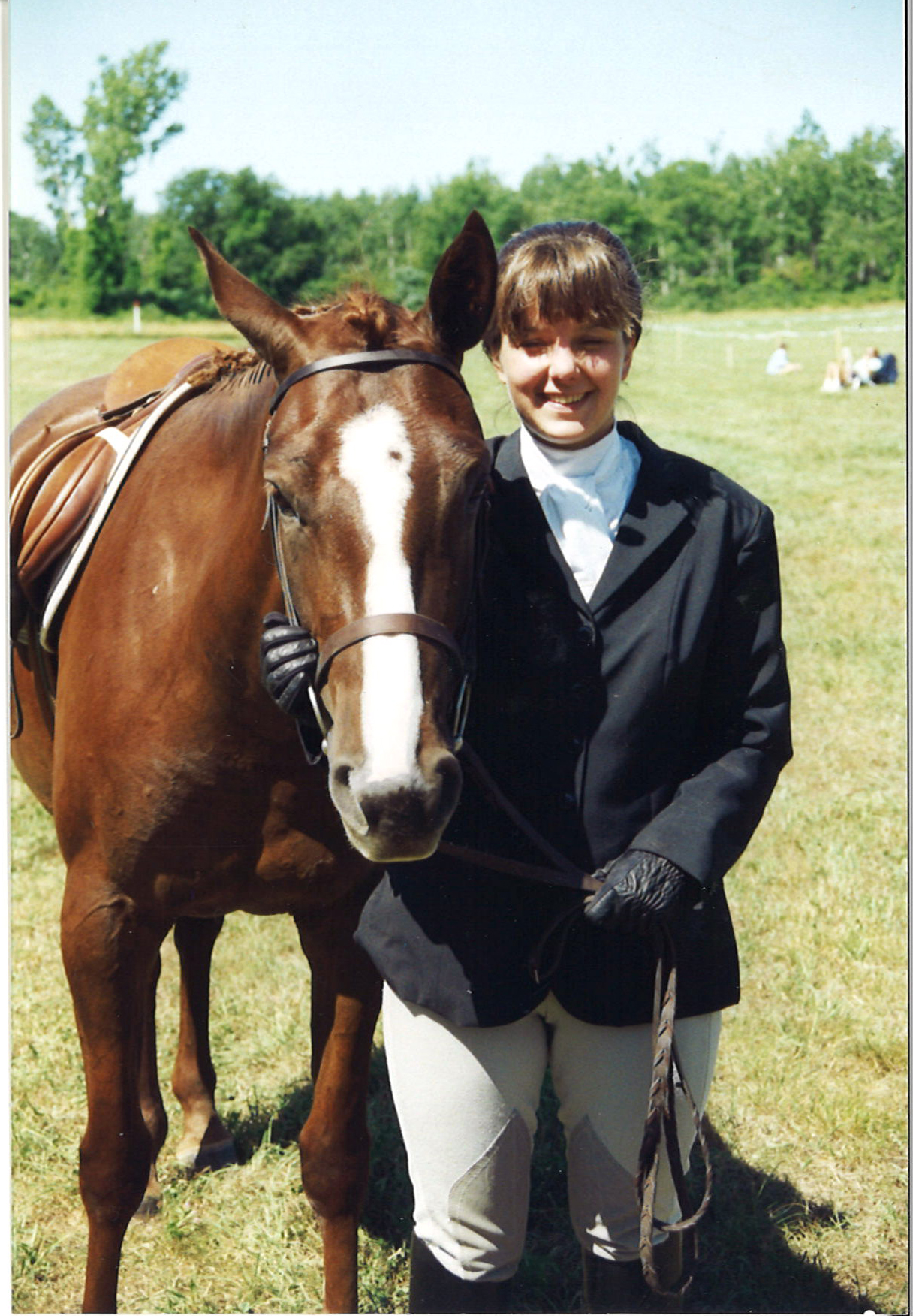Blog post by Karen Steffy.
Formal English riding apparel for women really hasn’t changed much in the last 100 years. Women who ride astride (not in a side-saddle) still wear boots and breeches, a riding jacket and stock tie or choker, and gloves. There’s a reason for that: the attire is functional and everything has a historical purpose.
The complete riding habit in the Cornell Costume & Textile Collection (items: #1286-jacket, #1289-breeches, #1453-equestrian shirt, #1467-stock pin, #1456-detachable collar, & #1461-riding stock) was worn by Gertrude Heim Klemm Remey in the 1920s. Mrs. Remey was a wealthy socialite during the early 20th century. She was accustomed to replenishing her wardrobe each season, and many of her purchases were made in Paris and New York. After the death of her first husband, Karl Daenzer Klemm, she married Charles Mason Remey of Washington, D.C., in 1931. She died tragically a year later. In 1939 her husband, a Cornell University architecture graduate, contacted Professor Beulah Blackmore and donated three large trunks of his late wife’s clothing, including day dresses, evening gowns, hats, shoes, purses, gloves, jewelry, hair combs, and other accessories. Among Gertrude Remey’s sport clothes was this complete riding habit.
Mrs. Remey’s tall riding boots came from James Moore, 21st West 47th St. in New York City. Tall boots keep the lower legs from being rubbed or pinched by stirrup leathers. They also protect the legs from being scratched by tree branches or brush when riding outdoors. The hard toe safeguards the foot if a horse accidentally steps on you. The slight heel keeps the foot from sliding through the stirrup.

Gertrude Remey’s riding habit, later donated to the CCTC by her husband, Charles Mason Remey. Please note that the bowler on the mannequin did not belong to Gertrude Heim Remey. And, speaking of headgear, the vast majority of hats have now been replaced by protective headgear. While not as sleek looking, most people have realized that protecting their head in a fall is much more important than looks!
The stock tie, which is about two feet long (CCTC #1461), and stock pin (CCTC#1467) can be used as a bandage for either horse or rider when hunting. Just like regular neckties, you can purchase a pre-tied stock if you choose, but many people stick with the traditional. It is almost a rite of passage to learn how to correctly tie a stock tie. The stock pin is always pinned horizontally to avoid stabbing yourself in the throat.
Mrs. Remey’s breeches (CCTC #1289) are a non-stretch fabric, which necessitated the flares at the top and the lacing and buttons at the bottom of the legs. The knee patches help with gripping the saddle and protecting the knees. With the introduction of stretch fabrics in the 1970s, breeches became more form fitting. The breeches I wore back in the late 1970s were of the “new” two-way stretch fabric and had zippers at the bottom of the legs. The zippers could be rather uncomfortable in a pair of tall boots. A few years later, I received a pair of four-way stretch breeches with Velcro at the bottom. They were pretty novel at the time. Now, of course, everything has spandex and is so much more comfortable. Breeches still have knee patches, either leather or synthetic, or “full seats” or some modification thereof to help riders stay in the saddle.
Again, with jackets, the biggest change is the use of spandex and technical fabrics. You can still purchase and wear wool jackets, which would be perfectly acceptable.

Jane Marie Law, Associate Professor of Religious Studies here at Cornell and Lucio sporting some bling. The ear net keeps the flies out of the horse’s ears.
Another thing that is changing is the way that little bits of bling are creeping onto clothing. (Traditionally, English riding apparel is rather conservative.) It started with just a little bit of piping on jackets, but now Swarovski crystals can be found on helmets, jackets, boots, spur straps and even gloves. I highly doubt that my tropical print schooling tights would ever be appropriate in the show ring, though!
One of the things I find really fascinating is the appropriation of riding clothes into the fashion world. Walking across campus, I see countless lace-up short boots, which would be a paddock boot for riders, “spurs” and “spur straps” on tall boots, and zippers and ties at the bottom of leggings, which originated on the bottom of our ancient non-stretch breeches. My favorites are the boots that mimic half chaps over a pair of paddock boots. I sometimes wonder how many people wearing these things know the origin of their clothing, and I wonder if they know that their equestrian style isn’t complete without a few smudges of dirt and some hay in the pockets!
Karen Steffy (Graduate Field Assistant in FSAD) first sat on a pony at the age of 10 and was hooked. (Sorry, mom and dad, not outgrowing the horse phase.) She started lessons at age 11 and acquired her first horse at 18 and had him for 6 years, until he passed away. After a short period of being horseless, she started riding again at age 25 and has ridden almost daily for the past 28 years. Karen started riding hunt seat, but switched to eventing (encompassing a dressage test, a course of cross-country jumps, and a course of stadium jumps) with McEireBrook Lady Kathleen, aka “Katie”, when she resumed riding in her late 20s. Karen quit competing after her son was born, and did some hunter pacing with Katie until she had to be retired in 2007 due to a pasture injury. Now, Karen rides dressage for the pleasure and feeling of accomplishment of training a horse.






I LOVE the habit of the woman whose things were donated. I wish we had coats in that color and style. I will have to settle for my blingy blue.
Karen,
I love hearing about people’s hidden talents and hobbies. Thanks for sharing!